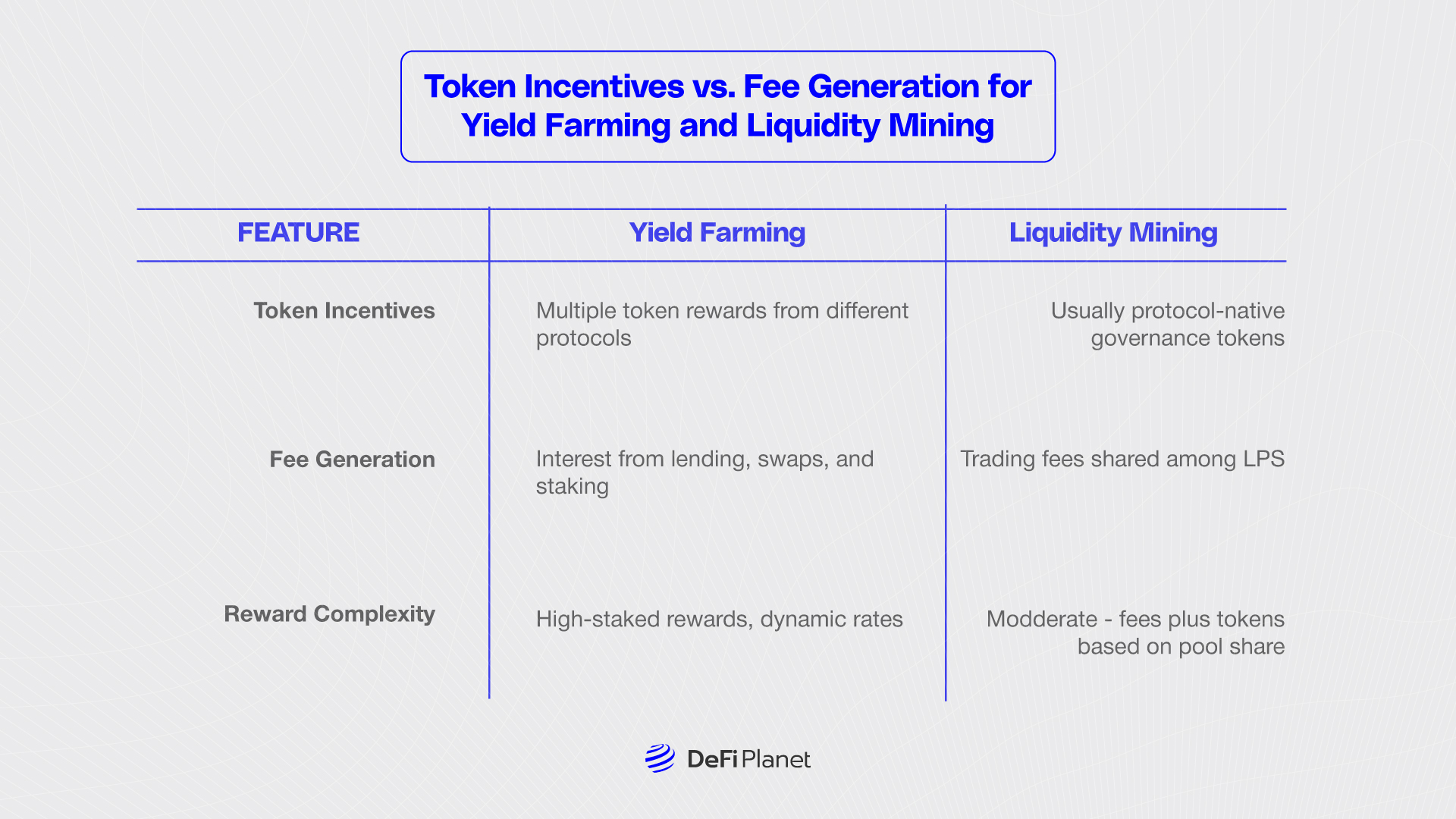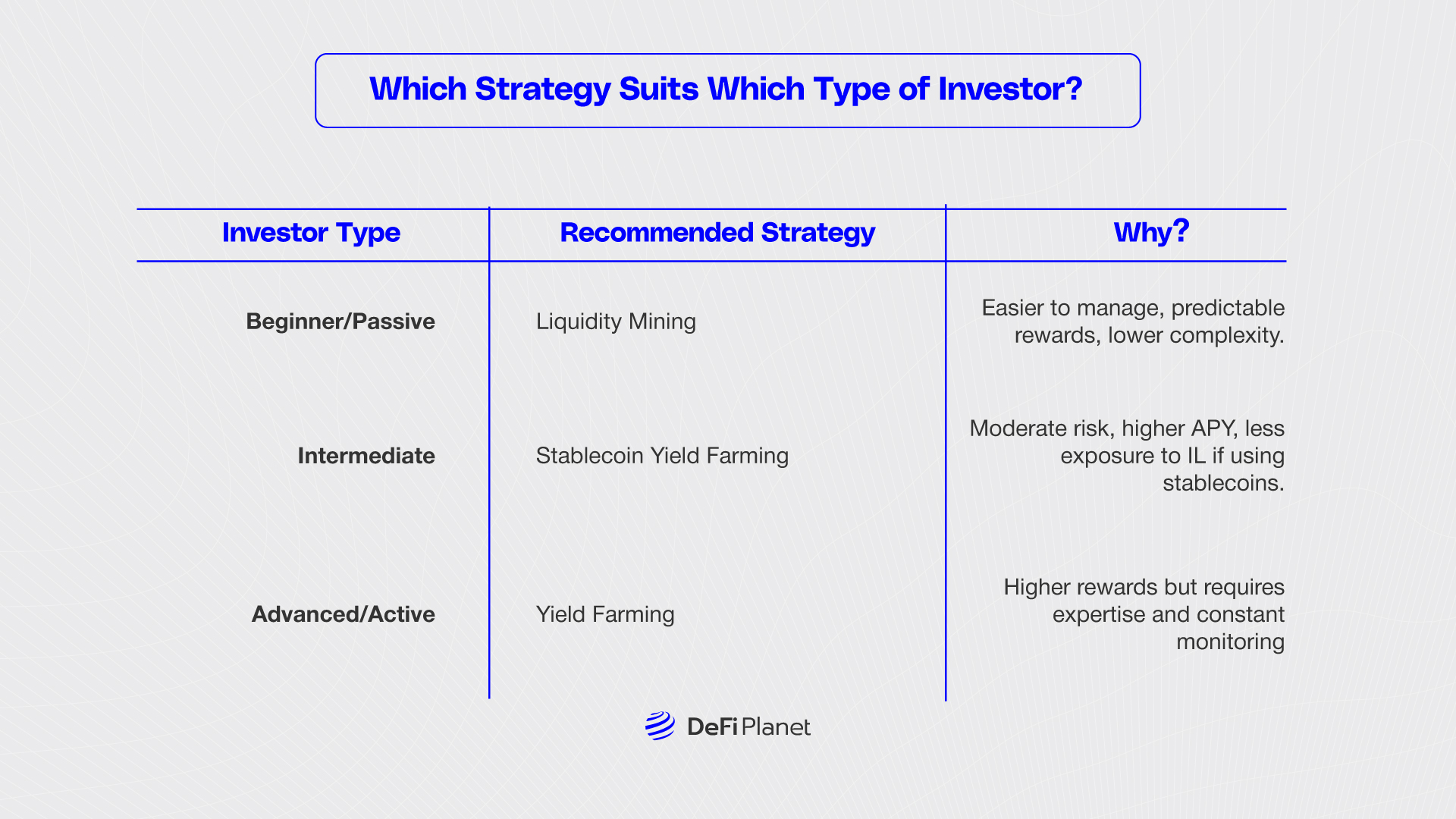When it comes to earning passive income with a DeFi protocol, two key concepts dominate the conversation: yield farming and liquidity mining. While these terms are often used interchangeably, they differ in design, risk level, and investor requirements.
This article breaks down the key differences between yield farming and liquidity mining, outlining how rewards are distributed, the role of token incentives, common risks such as impermanent loss and rug pulls, and which strategy suits different types of DeFi investors.
What Is Yield Farming?
Yield farming is an active strategy used by DeFi participants to earn the highest possible return on their crypto assets. It involves moving funds between various DeFi platforms to maximize APY (Annual Percentage Yield) by taking advantage of variable incentives, token rewards, and interest rates.
Rather than locking up assets in one place, yield farmers “chase yields“ by constantly reallocating funds to the protocols offering the best returns. These may include lending platforms, decentralized exchanges (DEXs) offering liquidity incentives, or aggregators that automatically optimize returns across protocols.
How does yield farming work?
- Users deposit assets into yield-generating smart contracts.
- Platforms may issue governance tokens (e.g., YFI, AAVE) as additional incentives.
- Some strategies use auto-compounding, where interest and rewards are reinvested.
- Advanced strategies may involve recursive lending or protocol stacking for increased returns.
Example: A yield farmer might deposit USDC into Curve Finance, earn CRV tokens, then stake those CRV tokens on Convex Finance to earn additional CVX rewards.
So, is yield farming still profitable? Yes, for active users with experience and risk tolerance. However, profitability depends on market trends, gas fees, and protocol reliability.
What Is Liquidity Mining?
Liquidity mining is a DeFi mechanism where users provide liquidity to decentralized protocols and, in return, receive reward tokens, usually native or governance tokens. This strategy supports the protocol’s ecosystem by improving trading efficiency and reducing slippage.
Liquidity providers (LPs) supply token pairs (like ETH/DAI) to liquidity pools on DEXs like Uniswap or SushiSwap. In exchange, they receive a share of trading fees and often liquidity mining rewards.
How does liquidity mining work?
- LPs deposit token pairs into a smart contract (liquidity pool).
- They receive LP tokens, representing their share of the pool.
- Platforms distribute fee revenue + governance tokens (e.g., UNI, SUSHI) as rewards.
Example: On Uniswap, a user who provides ETH and USDC into a liquidity pool earns a portion of the swap fees and may also receive UNI tokens if the protocol is running a liquidity mining program.
How Rewards Are Distributed
Yield Farming:
In yield farming, rewards are generated from several sources. The most common include interest earned from lending out assets, staking bonuses, and native reward tokens issued by DeFi protocols. These incentives are designed to attract liquidity and participation, offering users a steady stream of returns in exchange for locking up their assets.
But the real magic often happens when yield farmers tap into multiple protocols, stacking one strategy on top of another to unlock layers of returns. For example, a user might earn yield on a lending platform and then use those earnings to stake on a staking platform to earn even more.
To make things even more efficient, auto-compounding platforms like Beefy Finance come into play. These smart tools automatically reinvest your profits, whether they’re in the form of interest, tokens, or staking rewards, so that your annual percentage yield (APY) grows over time without requiring manual intervention. It’s compounding, but on autopilot, maximizing rewards while minimizing effort.
Liquidity Mining
In liquidity mining, rewards are typically distributed based on your share of a liquidity pool. The more liquidity you provide, the larger your slice of the reward pie. These rewards usually come in two forms: a portion of the trading fees generated by the pool, often around 0.3% per trade and additional token incentives offered by the platform to encourage participation.
One of the appealing aspects of liquidity mining is its passive nature. Once you’ve deposited your tokens into the pool, there’s little need for constant monitoring or repositioning. Rewards accumulate automatically over time, making it a relatively hands-off way to earn from your assets while contributing to the efficiency of decentralized exchanges.
One of the appealing aspects of liquidity mining is its passive nature. Once you’ve deposited your tokens into the pool, there’s little need for constant monitoring or repositioning. It’s one of the most accessible answers to how to earn passive income with a DeFi protocol.
Token Incentives vs. Fee Generation
While both yield farming and liquidity mining offer ways to earn passive income in DeFi, they differ significantly in how rewards are structured and delivered.
Yield farming typically involves multiple layers of token incentives. Users often receive rewards from multiple protocols simultaneously. For example, earning governance tokens like YFI or AAVE, alongside other bonus tokens. These tokens can typically be staked, traded, or used to participate in protocol governance. The reward mechanisms in yield farming are often complex, featuring stacked incentives, variable interest rates, and auto-compounding strategies that reinvest gains to achieve higher returns.
In contrast, liquidity mining usually focuses on protocol-native tokens as rewards, such as the platform’s own governance token. Here, rewards are tied more directly to the user’s share of the liquidity pool and may include a portion of the trading fees generated by the pool, typically around 0.3% per transaction. This setup is generally less intricate than yield farming, offering a moderate level of reward complexity: participants earn both fees and token incentives based on the amount of liquidity they provide.
When it comes to token utility, both models offer tradable and sometimes stakeable tokens, but yield farming tokens often have broader use cases, including voting rights and access to additional farming opportunities.
In short, yield farming is often a higher-risk, higher-reward strategy with dynamic, multi-protocol incentives. At the same time, liquidity mining provides a more streamlined, fee-driven approach to earning in DeFi.
Token Incentives vs. Fee Generation for Yield Farming and Liquidity Mining

The Hidden Risks Behind the Rewards: What Yield Farmers and Liquidity Miners Should Know
While the earning potential in yield farming and liquidity mining can be impressive, these strategies are far from risk-free. Understanding the hidden dangers is essential for protecting your assets and making informed decisions.
1. Impermanent loss (IL)
This occurs when the price ratio between the two assets in a liquidity pool shifts significantly after you’ve deposited them. Even if both assets increase in value, the imbalance can leave you with less than if you had simply held the tokens separately. Impermanent loss is particularly prevalent in liquidity pools featuring volatile or mismatched token pairs, making it a significant concern for liquidity miners.
2. Rug pulls
A rug pull happens when developers or insiders behind a project suddenly withdraw all the liquidity, leaving users stuck with worthless or illiquid tokens. These malicious events are often associated with unaudited, hyped-up protocols that pop up overnight. Due diligence and community reputation checks are crucial before committing any funds to new platforms.
3. Smart contract vulnerabilities
Yield farming and liquidity mining are powered by smart contracts, which are only as secure as the code they run on. Exploits, bugs, or logic flaws can be used by attackers to drain funds or manipulate rewards. Always look for platforms that are open-source, have undergone third-party security audits, and publish detailed documentation.
4. Protocol risk
Even legitimate platforms can change the rules unexpectedly, such as altering reward schedules, tokenomics, or governance parameters. Such changes can significantly impact your returns or necessitate prompt action to prevent losses. Yield farmers, in particular, need to stay alert and regularly monitor governance forums, updates, and protocol roadmaps.
Pro Tip: Use tools like DeFi Llama, Zapper, and Debank to track rewards and portfolio performance.
Which Strategy Suits Which Type of Investor?

Conclusion: Choosing the Right Path in DeFi
Though yield farming and liquidity mining both aim to generate income from crypto assets, the roads they take are quite different. Liquidity mining appeals to those who prefer a more passive approach, earning trading fees and protocol-native tokens simply by providing liquidity. It’s a steady, behind-the-scenes contribution that helps keep decentralized markets flowing.
Yield farming, on the other hand, is built for the hands-on strategist. It attracts users who enjoy actively chasing the highest yields, hopping between platforms, and stacking rewards using layered or even automated strategies. It’s a fast-paced game of optimization that often requires deep research and timely execution.
But no matter which path you choose, one truth remains constant in DeFi: high rewards often walk hand-in-hand with high risks. Your choice should reflect not just your financial goals, but also your risk tolerance, time availability, and technical confidence. With a solid plan, ongoing learning, and a healthy respect for the risks, both yield farming and liquidity mining can serve as powerful tools in building long-term crypto wealth.
Disclaimer: This article is intended solely for informational purposes and should not be considered trading or investment advice. Nothing herein should be construed as financial, legal, or tax advice. Trading or investing in cryptocurrencies carries a considerable risk of financial loss. Always conduct due diligence.
If you want to read more market analyses like this one, visit DeFi Planet and follow us on Twitter, LinkedIn, Facebook, Instagram, and CoinMarketCap Community.
Take control of your crypto portfolio with MARKETS PRO, DeFi Planet’s suite of analytics tools.”





















